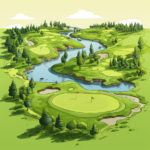Parkland golf courses are known for their lush, well-manicured fairways, plenty of trees, and fast greens. Unlike links courses, which are located along the coastlines, parkland courses are typically found inland, away from large bodies of water.
Parkland courses are a great fit for golfers who enjoy a challenging game with plenty of variety. The courses are designed to be both beautiful and challenging, with strategically placed bunkers, water hazards, and trees that require golfers to use a variety of shots. But despite the challenges, parkland courses are still accessible to golfers of all skill levels, making them a popular choice for both casual and serious golfers alike.
Key Takeaways
- Parkland golf courses are known for their scenic fairways, trees, and fast greens and are typically located inland.
- Parkland courses are generally a better fit for beginners
- Some of the most famous parkland courses in the world include Augusta National, Winged Foot, and Oak Hill.
What Type of Golfer are Parkland Courses Best For?
Parkland golf courses are suitable for golfers of all skill levels, especially beginners. They are particularly ideal for golfers who prefer a wide course with a lush green landscape. Parkland courses are built inland, away from the ocean, and often feature tree-lined fairways and manicured rough, giving golfers the feeling of playing golf in their local park.
The courses’ lush green rough makes it easier for golfers to find their ball and recover from errant shots. However, these courses typically also have tree-lined fairways, which make it more challenging to hit long, straight drives.
Parkland courses can feature several dozen types of grass, which can affect the ball’s roll and general strategy around chipping and putting. For example, Bermuda grass is commonly used on parkland courses in warmer climates and can be more challenging to chip and putt on due to its grainy texture. On the other hand, Bentgrass is commonly used on parkland courses in cooler climates and offers a smoother surface for chipping and putting.
Overall, parkland courses are more desirable for new and casual golfers compared to links-style or heathland courses.
Characteristics of Parkland Golf Courses
The origins of parkland courses can be traced back to the early days of golf when course grounds were primarily used for farming or hunting. Golfers would play on these courses, which were characterized by their natural setting and design elements, such as trees and shrubs. Over time, golfers began to create more structured courses with manicured greens, sand traps, water hazards, and much more. This led to the development of parkland courses, which are now the most common type of golf course in the United States.
Maintenance and Upkeep of Parkland Courses
Parkland courses require a lot of maintenance and upkeep to maintain their pristine condition. The grass is kept short and uniform, and the greens are kept smooth and fast. The rough is also maintained to a high standard, and the bunkers are raked regularly to ensure they are free of debris.
The trees and foliage around the course are also an important part of parkland courses. They provide a natural beauty and add to the challenge of the course by requiring golfers to navigate around them. The trees also provide shade, which can be a welcome relief on hot summer days.
Overall, parkland golf courses are designed to provide a challenging and enjoyable golfing experience for players of all skill levels. They offer a unique combination of natural beauty, well-manicured fairways and greens, and challenging hazards that make them a favorite among golfers worldwide.
Difference Between Parkland and Links Courses
Parkland and links courses are two types of golf courses that differ in terms of their geographical location, natural setting, and layout.
Parkland courses are generally inland courses that are situated away from coastal areas and large bodies of water. They are characterized by their heavily wooded areas, grassy fairways, and manicured greens. In contrast, links courses are situated around coastal and shore areas, and the course is made to fit in with the natural landscape. They are wide open without trees lining fairways and have a lack of water hazards. Links courses are usually very windy, and the terrain is rolling.
Links courses, on the other hand, originated in Scotland, where the game of golf was first played. Links courses were originally located on land that was unsuitable for farming or other uses and were characterized by their natural setting and design elements, such as sand dunes and undulating terrain. Over time, golfers began to create more structured courses with manicured greens, sand traps, and other design elements. This led to the development of links courses, which are now the most common type of golf course in Scotland and other coastal areas.
Links courses are generally said to be more challenging for golfers to play due to the layout of the course. The lack of trees lining the fairways and the presence of water hazards and undulating terrain make it more difficult to hit accurate shots. Parkland courses, on the other hand, tend to favor high ball flights and accurate approach shots.
Overall, the difference between parkland and links courses lies in their geographical location, natural setting, and design elements. While both types of courses provide an engaging and challenging golf experience, golfers may prefer one type of course over the other, depending on their playing style and preferences.
Difference Between Parkland and Desert Courses
The biggest difference between parkland and desert courses is that parkland courses are typically found inland, while desert courses are located in arid regions. Additionally, parkland courses are generally played during the summer months while desert courses are played in the fall and winter
Desert courses typically feature sand dunes, rocky outcroppings, and cacti. They also typically feature drought-resistant grasses, such as Bermuda and Fescue. Desert courses can be challenging for golfers due to the unpredictable winds and the difficulty of hitting out of the sand and rough.
In summary, parkland courses are more traditional and easier to play on, while desert courses offer a unique challenge with their rugged terrain and unpredictable conditions.
What are the Most Famous Parkland Golf Courses?
Several notable parkland courses include Winged Foot Golf Club in New York, Oakmont Country Club in Pennsylvania, and Merion Golf Club in Pennsylvania. These courses have played host to numerous major championships and are known for their challenging layouts and beautiful scenery.
History of Parkland Courses
One of the most famous parkland courses in the world is Augusta National Golf Club, which hosts the annual Masters Tournament. This historic course has been around since 1933 and has undergone several renovations over the years to maintain its high standards.
Another legendary parkland course is Pebble Beach Golf Links in California, which has been ranked as one of the top courses in the world. The course has hosted several major championships, including the U.S. Open, and features stunning views of the Pacific Ocean.
Overall, parkland courses offer a unique golfing experience that combines the beauty of nature with the challenges of a well-designed course. Whether you’re a professional golfer or a recreational player, these courses are sure to provide a memorable and enjoyable round of golf.
Frequently Asked Questions
What are the challenges of playing on a links golf course?
The biggest challenges of playing on a links course include navigating the unpredictable and often strong coastal winds, dealing with uneven lies on the undulating fairways, and avoiding the deep bunkers and natural hazards such as gorse and heather. Additionally, the fairways tend to be narrow, which makes it more likely for golfers to lose balls more frequently.
What types of golf courses exist besides parkland and links?
Aside from parkland and links courses, desert courses, mountain courses, exectuive courses, and par-3 courses are the most common “types” of golf courses.
What factors should I consider when choosing between a parkland and a links golf course?
The most important factors for choosing the right golf course is to understand your skill level, preferred terrain, and budget.






